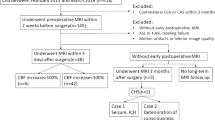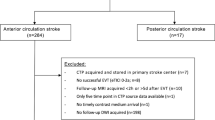Abstract
Introduction
Statistical parametric mapping (SPM) and statistical probabilistic anatomical mapping (SPAM) were applied to basal/acetazolamide Tc-99m ECD brain perfusion SPECT images in patients with middle cerebral artery (MCA) stenosis to assess the efficacy of endovascular stenting of the MCA.
Methods
Enrolled in the study were 11 patients (8 men and 3 women, mean age 54.2 ± 6.2 years) who had undergone endovascular stent placement for MCA stenosis. Using SPM and SPAM analyses, we compared the number of significant voxels and cerebral counts in basal and acetazolamide SPECT images before and after stenting, and assessed the perfusion changes and cerebral vascular reserve index (CVRI).
Results
The numbers of hypoperfusion voxels in SPECT images were decreased from 10,083 ± 8,326 to 4,531 ± 5,091 in basal images (P = 0.0317) and from 13,398 ± 14,222 to 7,699 ± 10,199 in acetazolamide images (P = 0.0142) after MCA stenting. On SPAM analysis, the increases in cerebral counts were significant in acetazolamide images (90.9 ± 2.2 to 93.5 ± 2.3, P = 0.0098) but not in basal images (91 ± 2.7 to 92 ± 2.6, P = 0.1602). The CVRI also showed a statistically significant increase from before stenting (median 0.32; 95% CI −2.19–2.37) to after stenting (median 1.59; 95% CI −0.85–4.16; P = 0.0068).
Conclusion
This study revealed the usefulness of voxel-based analysis of basal/acetazolamide brain perfusion SPECT after MCA stent placement. This study showed that SPM and SPAM analyses of basal/acetazolamide Tc-99m brain SPECT could be used to evaluate the short-term hemodynamic efficacy of successful MCA stent placement.






Similar content being viewed by others
References
Wityk R, Lehman D, Klag M, et al (1996) Race and sex-differences in the distribution of cerebral atherosclerosis. Stroke 27:1974–1980
Wong K, Huang Y, Gao S, et al (1998) Intracranial stenosis in Chinese patients with acute stroke. Neurology 50:812–813
Marzewski DJ, Furlan AJ, St Louis P, et al (1982) Intracranial internal carotid artery stenosis: long-term prognosis. Stroke 13:821–824
Caplan LR, Babikian V, Helgason C, et al (1985) Occlusive disease of the middle cerebral artery. Neurology 35:975–982
Li H, Wong KS (2003) Racial distribution of intracranial and extracranial atherosclerosis. J Clin Neurosci 10:30–34
Arenillas JF, Molina CA, Montaner J, et al (2001) Progression and clinical recurrence of symptomatic middle cerebral artery stenosis: a long-term follow-up transcranial doppler ultrasound study. Stroke 32:2898–2904
Warfarin-Aspirin Symptomatic Intracranial Disease (WASID) Study Group (1998) Prognosis of patients with symptomatic vertebral or basilar artery stenosis. Stroke 29:1389–1392
Powers WJ, Grubb RL, Raichle ME (1989) Clinical results of extracranial-intracranial bypass surgery in patients with hemodynamic cerebrovascular disease. J Neurosurg 70:61–67
Klijn CJ, Kappelle LJ, van der Zwan A, et al (2002) Excimer laser assisted high flow extracranial/intracranial bypass in patients with symptomatic carotid artery occlusion at high risk of recurrent cerebral ischemia: safety and long-term outcome. Stroke 33:2451–2458
The EC/IC Bypass Study Group (1985) Failure of extracranial-intracranial arterial bypass to reduce the risk of ischemic stroke. Results of an international randomized trial. N Engl J Med 313:1191–1200
Nahser HC, Henkes H, Weber W, et al (2000) Intracranial vertebrobasilar stenosis: angioplasty and follow-up. AJNR Am J Neuroradiol 21:1293–1301
Lee TH, Kim DH, Lee BH, et al (2005) Preliminary results of endovascular stent-assisted angioplasty for symptomatic middle cerebral artery stenosis. AJNR Am J Neuroradiol 26:166–174
Jiang WJ, Wang YJ, Du B, et al (2004) Stenting of symptomatic M1 stenosis of middle cerebral artery: an initial experience of 40 patients. Stroke 35:1375–1380
Barber PA, Consolo HK, Yang Q, et al (2001) Comparison of MRI perfusion imaging and single photon emission computed tomography in chronic stroke. Cerebrovasc Dis 11:128–136
Lee HY, Paeng JC, Lee DS, et al (2004) Efficacy assessment of cerebral arterial bypass surgery using statistical parametric mapping and probabilistic brain atlas on basal/acetazolamide brain perfusion SPECT. J Nucl Med 45:202–206
Penhune VB, Zatorre RJ, MacDonald JD, et al (1996) Interhemispheric anatomical differences in human primary auditory cortex: probabilistic mapping and volume measurement from magnetic resonance scans. Cereb Cortex 6:661–672
North American Symptomatic Endarterectomy Trial Collaborators (1991) Beneficial effect of carotid endarterectomy in symptomatic patients with high-grade stenosis. N Engl J Med 325:445–453
Chang L (1987) A method for attenuation correction in computed tomography. IEEEE Trans Nucl Sci 25:638–643
Soonawala D, Amin T, Ebmeier KP, Steele JD, Dougall NJ, Best J, Migneco O, Nobili F, Scheidhauer K (2002) Statistical parametric mapping of 99mTc-HMPAO-SPECT images for the diagnosis of Alzheimer’s disease: normalizing to cerebellar tracer uptake. Neuroimage 17:1193–1202
Talairach J, Tournoux P (1998) Coplanar stereotaxic atlas of the human brain. Thieme Medical, New York
Lee JS, Lee DS (2005) Analysis of functional brain images using population-based probabilistic atlas. Curr Med Imaging Rev 1:81–87
Piotin M, Spelle L, Martin JB, et al (2000) Percutaneous transluminal angioplasty and stenting of the proximal vertebral artery for symptomatic stenosis. AJNR Am J Neuroradiol 21:727–731
Nabavi DG, LeBlanc LM, Baxter B (2001) Monitoring cerebral perfusion after subarachnoid hemorrhage using CT. Neuroradiology 43:7–16
Eastwood JD, Alexander MJ, Petrella JR, Provenzale JM (2002) Dynamic CT perfusion imaging with acetazolamide challenge for the preprocedural evaluation of a patient with symptomatic middle cerebral artery occlusive disease. AJNR Am J Neuroradiol 23:285–287
Stamatakis EA, Glabus MF, Wyper DJ, Barnes A, Wilson JTL (1999) Validation of statistical parametric mapping (SPM) in assessing cerebral lesions: a simulation study. Neuroimage 10:397–407
Chang DJ, Zubal G, Gottschalk C, Necochea A, Stokking R, Studholme C, Corsi M, Slawski J, Spencer SS, Blumenfeld H (2002) Comparison of statistical parametric mapping and SPECT imaging in patients with temporal lobe epilepsy. Epilepsia 43:68–74
Rosenfeld A, Kak AC (1982) Digital picture processing. Academic Press, New York
Hopfinger JB, Buchel C, Holmes AP, Friston KJ (2000) A study of analysis parameters that influence the sensitivity of event-related fMRI analyses. Neuroimage 11:326–333
Worsley KJ, Marrett S, Neelin P, Evans AC (1996) Searching scale space for activation in PET images. Hum Brain Mapping 4:74–90
Acknowledgement
This study was supported by a grant from the Korea Ministry of Science and Technology Radiation Applied Neuroscience (M2 050407000405A070700410).
Conflict of interest statement
We declare that we have no conflict of interest.
Author information
Authors and Affiliations
Corresponding author
Rights and permissions
About this article
Cite this article
Lee, TH., Kim, SJ., Kim, IJ. et al. Statistical parametric mapping and statistical probabilistic anatomical mapping analyses of basal/acetazolamide Tc-99m ECD brain SPECT for efficacy assessment of endovascular stent placement for middle cerebral artery stenosis. Neuroradiology 49, 289–298 (2007). https://doi.org/10.1007/s00234-006-0188-7
Received:
Accepted:
Published:
Issue Date:
DOI: https://doi.org/10.1007/s00234-006-0188-7




